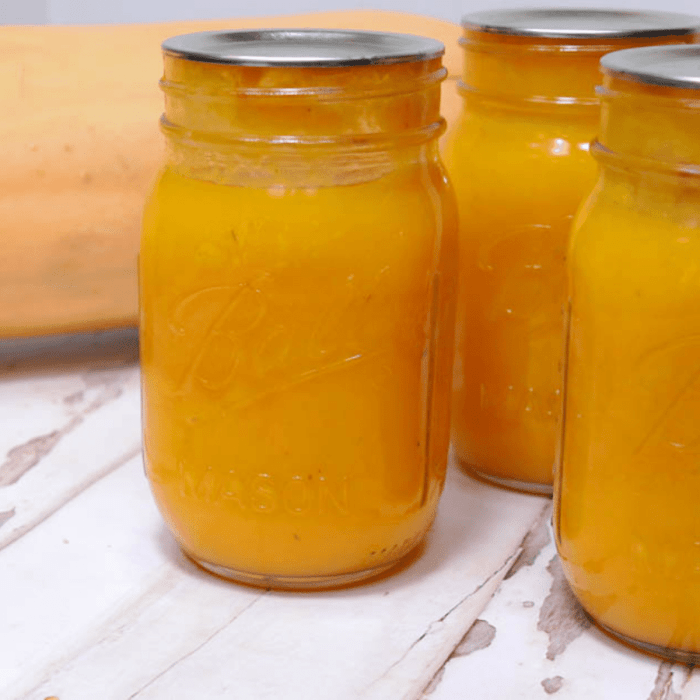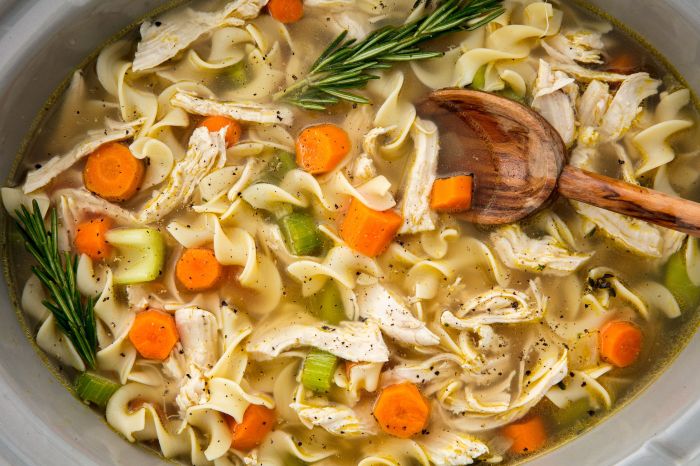Recipe Variations: Canned Butternut Squash Soup Recipe
Canned butternut squash soup recipe – Canned butternut squash soup offers a convenient base for a variety of delicious and flavorful variations. By adding different ingredients and employing various thickening techniques, you can easily customize this recipe to suit your preferences and create unique culinary experiences. The following sections detail several options for enhancing your canned butternut squash soup.
Flavor Profile Variations
The simplicity of canned butternut squash soup allows for considerable flexibility in adjusting its flavor profile. Below is a table outlining three distinct variations, each showcasing a different flavor emphasis.
| Recipe Name | Key Ingredients | Flavor Profile | Description |
|---|---|---|---|
| Spicy Chipotle Butternut Squash Soup | Chipotle peppers in adobo sauce, lime juice, cilantro | Spicy | This variation adds a smoky heat with chipotle peppers, balanced by the brightness of lime and the freshness of cilantro. The spice level can be adjusted to personal preference. |
| Creamy Coconut Curry Butternut Squash Soup | Coconut milk, curry powder, ginger, garam masala | Creamy | The richness of coconut milk creates a luxuriously creamy texture, while curry powder, ginger, and garam masala deliver warm, aromatic spices. This version offers a comforting and flavorful experience. |
| Savory Sage and Brown Butter Butternut Squash Soup | Brown butter, fresh sage, toasted pecans, crumbled goat cheese | Savory | The nutty depth of brown butter complements the earthy notes of sage, creating a sophisticated and savory soup. Toasted pecans add textural contrast, while crumbled goat cheese provides a tangy finish. |
Thickening Methods
Several methods can be used to thicken canned butternut squash soup, each with its own advantages and disadvantages. Choosing the right method depends on your desired consistency and available ingredients.
The following methods provide different approaches to achieving the desired thickness:
- Roux: A roux is a mixture of equal parts butter and flour cooked together until it forms a paste. Adding a roux to the soup and simmering it gently thickens the soup.
- Pros: Creates a smooth, creamy texture. Relatively easy to make.
- Cons: Can impart a slightly floury taste if not cooked properly. Requires extra cooking time.
- Pureed Vegetables: Adding a puree of cooked vegetables, such as carrots or potatoes, to the soup will thicken it naturally.
- Pros: Adds nutritional value and enhances the flavor. No noticeable change in taste.
- Cons: Requires extra preparation time for cooking and pureeing the vegetables.
- Cornstarch Slurry: A cornstarch slurry (cornstarch mixed with cold water) is a quick and effective way to thicken the soup. It should be added slowly while whisking constantly.
- Pros: Quick and easy method. Creates a smooth consistency.
- Cons: Can result in a slightly gummy texture if not added carefully. The soup may become too thick if too much is added.
Unexpected Ingredient Variation: Apple-Cranberry Butternut Squash Soup
This variation incorporates the sweetness and tartness of apples and cranberries to create a unique flavor profile.
The rationale behind each ingredient choice is as follows:
- Apples: The sweetness of apples balances the earthiness of the butternut squash, adding a touch of natural sweetness without relying on added sugar.
- Cranberries: The tartness of cranberries provides a delightful contrast to the sweetness of the apples and the butternut squash, adding complexity and depth of flavor. They also provide a vibrant color and a slightly chewy texture.
- Maple Syrup (optional): A touch of maple syrup can further enhance the sweetness and create a warm, autumnal flavor. It complements the apples and cranberries beautifully.
Ingredient Substitutions

Source: 1898mama.com
Making substitutions in your canned butternut squash soup recipe can lead to exciting variations in flavor and texture. Understanding the role of each ingredient allows for creative adjustments while maintaining a delicious result. This section will explore suitable alternatives for key components and their impact on the final product.
Butternut Squash Substitutes
Canned butternut squash provides convenience and a consistent texture. However, several alternatives offer unique characteristics. Pumpkin puree, for instance, offers a similar sweetness and creamy texture, though its flavor profile is slightly different, leaning towards a more spiced note. Sweet potato puree, while less sweet, contributes a rich, earthy flavor and a slightly denser consistency. Kabocha squash puree, another excellent option, delivers a subtle sweetness and a smooth, velvety texture comparable to butternut squash.
The choice depends on the desired flavor profile and texture; pumpkin will maintain a similar sweetness, sweet potato will add earthiness, and kabocha will provide a close match to butternut squash’s texture and mild sweetness.
Broth Substitutions
The type of broth used significantly impacts the soup’s overall flavor profile. Choosing a broth that complements the sweetness of the squash is key.
- Chicken Broth: Adds a savory depth and enhances the richness of the soup, creating a more complex flavor profile. The slight saltiness of chicken broth can also balance the sweetness of the squash.
- Vegetable Broth: Offers a lighter, cleaner taste, allowing the natural sweetness of the butternut squash to shine through. This is a great option for vegetarians or those seeking a less intense flavor.
- Beef Broth: Introduces a bolder, more robust flavor that may overpower the subtle sweetness of the squash. This substitution is best suited for those who prefer a savory, meaty undertone in their soup.
Flavor Enhancers, Canned butternut squash soup recipe
Several pantry staples can elevate the canned butternut squash soup without significant recipe alterations.
- Maple Syrup: A small amount of maple syrup can enhance the natural sweetness of the squash, adding a touch of sophistication and depth. Avoid using too much, as it could overpower the other flavors.
- Fresh Sage: A few leaves of fresh sage add an aromatic herbal note that beautifully complements the sweetness and earthiness of the squash. Its subtle peppery notes create a pleasant complexity.
- Ground Nutmeg: A pinch of ground nutmeg introduces a warm, subtly sweet spice that blends seamlessly with the butternut squash. Use sparingly to avoid overpowering the other flavors. A touch of cinnamon could also work well, adding a complementary warmth.
Serving Suggestions & Enhancements

Source: thecozycook.com
Transforming canned butternut squash soup from a simple meal to a culinary delight involves thoughtful consideration of presentation and serving style. Elevating this classic comfort food is easily achieved through careful garnishing and creative serving methods. The following suggestions offer a variety of options to enhance both the visual appeal and the overall taste experience.
Unique Garnishes for Enhanced Flavor and Presentation
Adding the right garnish can significantly impact the taste and visual appeal of your butternut squash soup. The following suggestions offer a range of textures and flavors to complement the sweetness of the squash.
- Toasted Pepitas: The nutty flavor and satisfying crunch of toasted pepitas provide a delightful textural contrast to the creamy soup. Their pale green color also adds visual interest.
- Crispy Sage Leaves: Deep-fried or baked sage leaves offer a fragrant, slightly earthy counterpoint to the squash’s sweetness. Their vibrant green color provides a beautiful contrast against the soup’s orange hue.
- Candied Pecans: The sweet and crunchy candied pecans add a layer of complex flavor and a pleasing textural element. Their rich brown color adds depth to the overall presentation.
- Chives and Crème Fraîche Swirl: A simple yet elegant garnish, a swirl of crème fraîche topped with finely chopped chives adds a touch of richness and freshness. The white crème fraîche contrasts beautifully with the orange soup and the green chives.
- Pumpkin Seeds and Maple Syrup Drizzle: Roasted pumpkin seeds offer a nutty flavor and satisfying crunch, while a delicate drizzle of maple syrup adds a touch of sweetness and visual appeal. The combination of earthy pumpkin seeds and amber maple syrup creates a harmonious blend of colors and flavors.
Serving Styles for Different Occasions
The versatility of butternut squash soup allows it to be served in a variety of ways, depending on the occasion and desired culinary experience.
- As a Starter: Serve a small portion of the soup in elegant bowls, garnished with a swirl of crème fraîche and a sprinkle of toasted pepitas. This light and flavorful starter will whet the appetite for the main course.
- As a Main Course: For a heartier meal, serve a larger portion of the soup in a bowl, topped with grilled chicken or shrimp, and garnished with crispy sage leaves and candied pecans. This creates a more substantial and satisfying meal.
- As a Side Dish: Serve the soup in small ramekins or bowls alongside a main course such as roast chicken or grilled fish. A simple garnish of chives is sufficient in this context, allowing the soup to complement the main dish without overpowering it.
Creating a Visually Appealing Presentation
The presentation of the soup is just as important as its taste. Using color, texture, and plating techniques can transform a simple bowl of soup into a visually stunning dish.
Consider using contrasting colors in your garnishes to create visual interest. For example, the vibrant green of sage leaves against the orange of the soup creates a striking contrast. The textures of the garnishes should also be varied; a combination of crunchy and creamy elements will enhance the overall dining experience.
The soup itself should be poured carefully into the bowl, avoiding spills or uneven surfaces. The garnish should be arranged thoughtfully, creating a visually pleasing pattern or design. Simple plating techniques, such as using a spoon to create a swirl effect in the soup or strategically placing the garnish around the bowl’s perimeter, can elevate the overall presentation.
Using a bowl that complements the soup’s color is also an important detail. For example, a white or cream-colored bowl will make the soup’s orange color pop.
Nutritional Information & Health Aspects
Butternut squash soup, whether homemade or from a can, offers a nutritious and flavorful meal option. Understanding its nutritional profile and the health benefits derived from consuming it is crucial for making informed dietary choices. This section details the nutritional composition of a typical canned butternut squash soup and compares it to its homemade counterpart, highlighting the advantages of this versatile vegetable.
Nutritional Breakdown of Canned Butternut Squash Soup
The nutritional content of canned butternut squash soup can vary depending on the brand and specific recipe. However, a general approximation per one-cup serving might include the following values. Note that these values are estimates and should be verified using the nutritional information provided on the specific can you purchase.
| Nutrient | Amount per Serving (approx.) | Unit | % Daily Value (approx.) |
|---|---|---|---|
| Calories | 150-200 | kcal | 7-10% |
| Total Fat | 3-5 | g | 4-7% |
| Saturated Fat | 1-2 | g | 5-10% |
| Cholesterol | 0 | mg | 0% |
| Sodium | 300-500 | mg | 13-22% |
| Total Carbohydrate | 25-35 | g | 8-12% |
| Dietary Fiber | 3-5 | g | 12-20% |
| Sugars | 8-12 | g | – |
| Protein | 3-5 | g | 6-10% |
| Vitamin A | 2000-4000 | IU | 40-80% |
| Vitamin C | 10-20 | mg | 11-22% |
| Potassium | 300-500 | mg | 7-11% |
Comparison of Homemade vs. Canned Butternut Squash Soup
Homemade butternut squash soup generally contains less sodium and added sugars compared to canned varieties. Canned soups often include preservatives and additives to enhance shelf life and flavor. The nutritional content of homemade soup is also more easily controlled, allowing for adjustments to suit individual dietary needs and preferences. For example, a homemade version might include more fresh herbs and spices, resulting in a higher concentration of antioxidants.
Conversely, canned soup offers convenience and a readily available option.
A simple canned butternut squash soup recipe offers a comforting and nutritious meal. If you’re looking for lighter options for weight management, you might also consider exploring alternative recipes, such as those found in this helpful guide on cabbage soup for weight loss recipes. However, returning to the butternut squash, its creamy texture and subtle sweetness make it a versatile ingredient for various healthy soups.
Health Benefits of Butternut Squash and its Soup
Butternut squash is an excellent source of beta-carotene, a precursor to vitamin A, which is crucial for maintaining healthy vision, immune function, and skin health. Its high fiber content aids in digestion and promotes feelings of fullness, potentially supporting weight management. The potassium in butternut squash contributes to healthy blood pressure levels. Furthermore, butternut squash is a good source of vitamin C, an antioxidant that supports the immune system and protects against cell damage.
Consuming butternut squash soup provides access to these beneficial nutrients in a palatable and easily digestible form. The added ingredients in a soup recipe, such as onions, garlic, and ginger, can further boost its nutritional profile and antioxidant content.
Recipe Optimization & Troubleshooting

Source: creativecanning.com
Creating a delicious and satisfying canned butternut squash soup requires attention to detail. While using canned squash simplifies the process, several factors can impact the final product’s flavor and texture. Understanding common pitfalls and implementing optimization strategies can elevate your soup from good to exceptional.Common Mistakes and Their SolutionsMany issues arise from improper handling of ingredients or a lack of attention to seasoning and blending.
Addressing these issues proactively will result in a smoother, more flavorful soup.
- Mistake: Using overly thick or thin soup. Solution: Adjust the consistency by adding more broth (for thinner soup) or simmering uncovered to reduce liquid (for thicker soup). Start with a smaller amount of adjustment and taste as you go to avoid over-correcting.
- Mistake: Inconsistent blending. Solution: Blend the soup thoroughly until completely smooth, using an immersion blender or carefully transferring the soup to a standard blender in batches. Avoid leaving any chunky pieces.
- Mistake: Under-seasoning or unbalanced flavors. Solution: Taste the soup throughout the cooking process and adjust seasonings accordingly. Start with a base of salt, pepper, and perhaps a touch of nutmeg, then add other spices or herbs to complement the sweetness of the squash. Consider adding a pinch of sugar to balance acidity if needed.
- Mistake: Using low-quality ingredients. Solution: Opt for high-quality canned butternut squash, flavorful broth, and fresh herbs and spices whenever possible. The quality of your ingredients directly impacts the final taste of the soup.
- Mistake: Overcooking the soup. Solution: Avoid prolonged simmering, as this can lead to a mushy texture. Once the soup is heated through and the flavors have melded, remove it from the heat to prevent further cooking.
Optimizing for Specific Dietary Needs
Adapting a canned butternut squash soup recipe to suit various dietary restrictions is straightforward. Simple substitutions and adjustments can make this comforting dish accessible to everyone.
- Vegan Adaptation: Ensure that your broth is vegetable-based and that any added dairy (like cream or butter) is replaced with plant-based alternatives such as coconut milk or cashew cream. Many vegan-friendly spices and herbs can enhance the flavor profile.
- Gluten-Free Adaptation: This recipe is naturally gluten-free, provided you use gluten-free broth and avoid any gluten-containing additions such as thickened sauces that may contain wheat.
- Low-Sodium Adaptation: Use low-sodium or no-salt-added canned butternut squash and broth. Season cautiously, adding herbs and spices to build flavor instead of relying heavily on salt. Consider using other seasonings like garlic powder, onion powder, or smoked paprika for depth of flavor.
Flavor and Texture Enhancement Tips
Elevating the flavor and texture of canned butternut squash soup involves strategic additions and careful techniques.
- Enhance Flavor: Incorporate roasted garlic, caramelized onions, or a touch of maple syrup for added depth and sweetness. Fresh herbs like sage, thyme, or rosemary can add aromatic complexity. A squeeze of lemon juice at the end brightens the flavors.
- Improve Texture: For a creamier texture, blend the soup until perfectly smooth and consider adding a small amount of full-fat coconut milk or cashew cream before serving. A dollop of plain Greek yogurt or crème fraîche (for non-vegan versions) can also add richness and creaminess.
- Spice it Up: Add a pinch of cayenne pepper or a dash of hot sauce for a subtle kick. For a more complex flavor profile, consider adding curry powder or ginger.
FAQ Overview
Can I freeze leftover canned butternut squash soup?
Yes, canned butternut squash soup freezes well. Allow it to cool completely before storing in airtight containers for up to 3 months.
What happens if I use too much thickening agent?
Using too much thickener will result in a very thick, possibly pasty, soup. Start with a small amount and add more gradually until you reach your desired consistency.
How long can I store homemade butternut squash soup in the refrigerator?
Homemade butternut squash soup should be stored in an airtight container in the refrigerator for up to 4 days.
Can I use different spices besides the ones suggested?
Absolutely! Experiment with different spices to create your own unique flavor profile. Consider adding curry powder, smoked paprika, or even a pinch of nutmeg.


